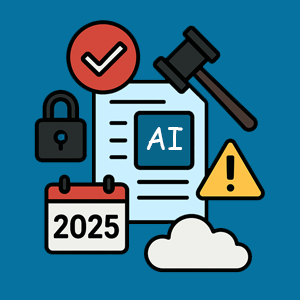 Artificial Intelligence has raced ahead, faster than any regulation could keep up with. But now, the tide is turning. In 2025, AI regulations are no longer hypothetical, they’re a business-critical reality. With the EU AI Act officially in force and the U.S. preparing its own sweeping compliance frameworks, B2B tech companies, from SaaS providers to cloud platforms, are facing a new challenge: compliance at scale.
Artificial Intelligence has raced ahead, faster than any regulation could keep up with. But now, the tide is turning. In 2025, AI regulations are no longer hypothetical, they’re a business-critical reality. With the EU AI Act officially in force and the U.S. preparing its own sweeping compliance frameworks, B2B tech companies, from SaaS providers to cloud platforms, are facing a new challenge: compliance at scale.
This is not just about risk mitigation. It’s about survival, competitive advantage, and long-term trust.
The EU AI Act: A Global Wake-Up Call
The European Union’s AI Act is the world’s first comprehensive AI regulation. It classifies AI systems by risk level (unacceptable, high, limited, minimal) and imposes strict obligations on developers and deployers of “high-risk” AI systems, many of which are deeply embedded in enterprise software platforms.
Key implications for B2B vendors:
- High-risk AI (e.g., HR tools, credit scoring, biometric ID) must meet rigorous requirements: transparency, human oversight, data governance, and post-deployment monitoring.
- Foundation model providers (e.g., LLM creators) must document training data, test for systemic risks, and maintain usage logs.
- Severe penalties: Up to €35 million or 7% of global annual turnover for non-compliance.
Even companies outside the EU must comply if their AI products touch European users, making this a de facto global standard, much like GDPR before it.
The U.S. Approach: Sectoral and State-Level Pressure
The United States is taking a more fragmented, sector-specific approach, but the pressure is mounting:
- The White House AI Executive Order (EO 14110) mandates new AI risk disclosures, red-team testing, and model safety reviews for federal vendors.
- State laws in California, Illinois, and Connecticut are targeting algorithmic hiring, data privacy, and biometric use.
- Federal bills (like the Algorithmic Accountability Act) are gaining traction, aiming to create baseline standards for impact assessments and bias mitigation.
The result is patchwork compliance, and a growing need for B2B vendors to build adaptable, auditable, and explainable AI systems by default.
What B2B Tech Companies Must Do Now
- Map Your AI Systems and Classify Risk
Start with an AI inventory. Identify where your products use machine learning, natural language processing, predictive analytics, or generative AI. Classify each use case by potential risk, especially if it touches recruitment, finance, healthcare, or user profiling.
- Adopt “Ethics by Design”
Bake in governance from the start. Document training data sources, implement fairness testing protocols, and ensure human-in-the-loop oversight where required. If your model influences high-impact decisions, bias mitigation isn’t optional, it’s mandatory.
- Update Your Contracts and Data Policies
Review licensing agreements, data usage disclosures, and customer-facing AI terms. Regulators are paying close attention to how AI decisions are communicated and whether users understand the role of automation.
- Design for Explainability
Black-box models are out. Regulators want explainable AI that can justify its outcomes. That means logging, visualization tools, and interpretability features must become part of your offering, especially for enterprise buyers in regulated sectors.
- Prepare for Independent Audits
Third-party audits, model testing, and system documentation will soon become table stakes. Build internal review mechanisms now and keep a compliance paper trail to demonstrate proactive governance.
Why Compliance Is a Competitive Advantage
While regulations introduce new burdens, they also open new doors. Enterprises are growing more selective about their AI vendors, preferring partners who offer transparency, control, and legal peace of mind.
Early movers in AI compliance will:
- Win enterprise trust
- Face fewer procurement hurdles
- Future-proof themselves against legal disruption
- Gain alignment with major global markets
In short, regulatory readiness is now a revenue strategy.
Final Thoughts
B2B companies can no longer afford to treat AI as a freewheeling experiment. The global regulatory landscape is hardening fast, and those who fail to adapt risk more than just fines. They risk reputational damage, customer loss, and operational chaos.
But with the right strategy, this is also an opportunity to lead with responsibility, innovate with integrity, and build a foundation for long-term AI success.
